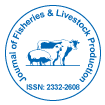Anti-Symmetry of First Upper Molar in Domestic Goats
Received Date: Sep 07, 2017 / Accepted Date: Nov 22, 2017 / Published Date: Sep 30, 2017
Abstract
Developmental instability theory suggests that variation in some body areas can partially reflect the ability to buffer development from key environmental and genetic perturbations. Developmental stability is defined as the ability of organisms to withstand genetic or environmental disturbances during development. Support for this approach comes mainly from assessment of fluctuating asymmetry - that is deviations from symmetry of body features that are symmetric at the population level. In order to compare developmental instability in domestic goats, we sampled 22 adult skulls. Length of upper molars (from M1 to M3), for each side, on their occlusal aspect, was measured and bilaterally compared using standard methods. Left-right differences in first upper molar (M1), which were not size-dependent, presented a platykurtic distribution. There was thus evidence of directional asymmetry towards the left side in M1.
Keywords: Bilateral symmetry; Capra; Developmental instability; Fluctuating asymmetry; Jugal teeth
Citation: Casanova PMP (2017) Anti-Symmetry of First Upper Molar in Domestic Goats. J Fisheries Livest Prod 5: 251. Doi: 10.4172/2332-2608.1000251
Copyright: © 2017 Casanova PMP. This is an open-access article distributed under the terms of the Creative Commons Attribution License, which permits unrestricted use, distribution, and reproduction in any medium, provided the original author and source are credited.
Share This Article
Recommended Journals
Open Access Journals
Article Tools
Article Usage
- Total views: 3590
- [From(publication date): 0-2017 - Mar 29, 2025]
- Breakdown by view type
- HTML page views: 2780
- PDF downloads: 810
